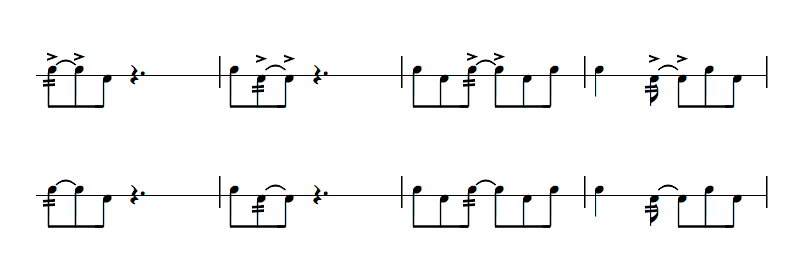Welcome to Part V of Roll Call! In this ten part series I'll be focusing on the identification and execution of rolls in the five styles of music we play. Today we'll be concentrating on the jig style. The jig style is written in 6/8 (a compound time signature). Compound time signatures are based on groups of three as opposed to the march and round reel styles that are based predominantly on groups of two and four. The rolls most commonly found in the jig style are as follows:
- Four Stroke Rolls
- Five Stroke Rolls
- Six Stroke Rolls
- Seven Stroke Rolls
- Eight Stroke Rolls
- Nine Stroke Rolls
- Sixteen Stroke Rolls
- Seventeen Stroke Rolls
Let's begin with fours and fives...
Four and Five Stroke Rolls
Both four and five stroke rolls begin with an eighth note. The first three examples below demonstrate how a four stroke roll appears when it begins on the first, second and third note of the triplet. Example #4 shows how the appearance of the four changes slightly when it begins on a single eighth note not physically connected to a triplet. The second row of examples are all five stroke rolls that differ from the fours slightly in that they begin with a buzz stroke and not a tap. This is indicated by the lack of an accent on the first note of the roll.

Six and Seven Stroke Rolls
Sixes and sevens can be recognized easily as they almost always start with a quarter note. In lower grade scores this is almost always the case as in examples #1 and #2. In example #3, which happens occasionally in upper grade scores, the sixes and sevens can begin on the third note of a triplet (an eighth note) and contain a "hidden" roll note. It should be noted that the first eighth note, when combined with the "hidden" eighth note, equal a quarter note. As with fours and fives, sixes have an accent on the first note and sevens do not.

Eight and Nine Stroke Rolls
Eight and nine stroke rolls are exactly one beat long (they are worth three eighth notes or, more commonly, a dotted quarter note). In lower grades nine stroke rolls are most commonly played on the beat as in example #1. In higher grade scores eights and nines can be played on either the second note of the triplet as in example #2 or the third note of the triplet as in example #3. Note that in examples #2 and #3 the starting note plus the "hidden" note add up to a dotted quarter note.

Sixteen and Seventeen Stroke Rolls
This is the first appearance of sixteen stroke rolls on this website. They are very rare and only appear occasionally in the jig and strathspey styles. The same holds true for seventeen stroke rolls. However, just because they are rare doesn't mean they don't pop up every once in a while. When you do see either a sixteen or seventeen it can be identified by the fact that it starts on either a dotted half note, as in example #1, or a dotted quarter note (used if the roll doesn't begin on the first beat of the bar).

In example #2 above, the sixteen begins on the second beat of the bar on a dotted quarter note but uses a "hidden" roll note. In example #3 the sixteen is written differently. It is played the same way as in example #1 but uses two dotted quarter notes tied together to show the number of beat involved. Older pipe band drum scores, and classical snare drum music, use this way of notating rolls. "Hidden" roll notes are found only in pipe band drumming notation. Example #4 shows the older way of writing example #2. Either way of writing these longer rolls is acceptable.
Next week we'll talk about the execution and use of rhythm syllables for all our rolls in the jig style. Until then, happy drumming!
